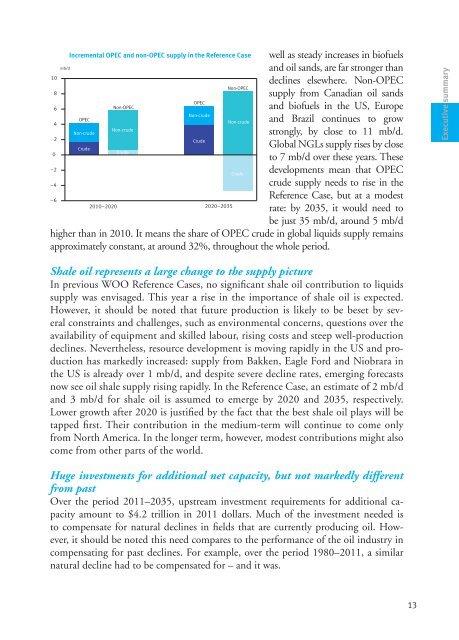World Oil Outlook - Opec
World Oil Outlook - Opec
World Oil Outlook - Opec
- TAGS
- world
- outlook
- opec
- www.opec.org
You also want an ePaper? Increase the reach of your titles
YUMPU automatically turns print PDFs into web optimized ePapers that Google loves.
10<br />
8<br />
6<br />
4<br />
Incremental OPEC and non-OPEC supply in the Reference Case<br />
well as steady increases in biofuels<br />
and oil sands, are far stronger than<br />
declines elsewhere. Non-OPEC<br />
supply from Canadian oil sands<br />
and biofuels in the US, Europe<br />
and Figure Brazil 1.30 continues to grow<br />
Non-crude<br />
Non-crude<br />
strongly, by close to 11 mb/d.<br />
2<br />
0<br />
Crude<br />
Crude<br />
Crude<br />
Global NGLs supply rises by close<br />
to 7 mb/d over these years. These<br />
–2<br />
–4<br />
Crude developments mean that OPEC<br />
crude supply needs to rise in the<br />
–6<br />
2010–2020 2020–2035<br />
Reference Case, but at a modest<br />
rate: by 2035, it would need to<br />
be just 35 mb/d, around 5 mb/d<br />
higher than in 2010. It means the share of OPEC crude in global liquids supply remains<br />
approximately constant, at around 32%, throughout the whole period.<br />
Shale oil represents a large change to the supply picture<br />
In previous WOO Reference Cases, no significant shale oil contribution to liquids<br />
supply was envisaged. This year a rise in the importance of shale oil is expected.<br />
However, it should be noted that future production is likely to be beset by several<br />
constraints and challenges, such as environmental concerns, questions over the<br />
availability of equipment and skilled labour, rising costs and steep well-production<br />
declines. Nevertheless, resource development is moving rapidly in the US and production<br />
has OPEC markedly crude oil supply increased: in the three supply scenarios from Bakken, Eagle Ford and Niobrara in<br />
the mb/d US is already over 1 mb/d, and despite severe decline rates, emerging forecasts<br />
now 44 see oil shale supply rising rapidly. In the Reference Case, an estimate of 2 mb/d<br />
42 and 3 mb/d for shale oil is assumed to emerge by 2020 and 2035, respectively.<br />
40<br />
Lower growth after 2020 is justified by HEGthe<br />
fact that the best shale oil plays will be<br />
38<br />
tapped 36 first. Their contribution in the medium-term will continue to come only<br />
Reference Case<br />
from 34 North America. In the longer term, however, modest Figure contributions 4.1 might also<br />
32 come from other parts of the world.<br />
30<br />
28<br />
mb/d<br />
OPEC<br />
Non-OPEC<br />
OPEC<br />
Non-crude<br />
Non-OPEC<br />
Non-crude<br />
LEG<br />
Huge investments for additional net capacity, but not markedly different<br />
26<br />
from 24 past<br />
LSS<br />
Over 22 the period 2011–2035, upstream investment requirements for additional ca-<br />
2000 2005 2010 2015 2020 2025 2030 2035<br />
pacity amount to $4.2 trillion in 2011 dollars. Much of the investment needed is<br />
to compensate for natural declines in fields that are currently producing oil. However,<br />
it should be noted this need compares to the performance of the oil industry in<br />
compensating for past declines. For example, over the period 1980–2011, a similar<br />
natural decline had to be compensated for – and it was.<br />
13<br />
Executive summary
















